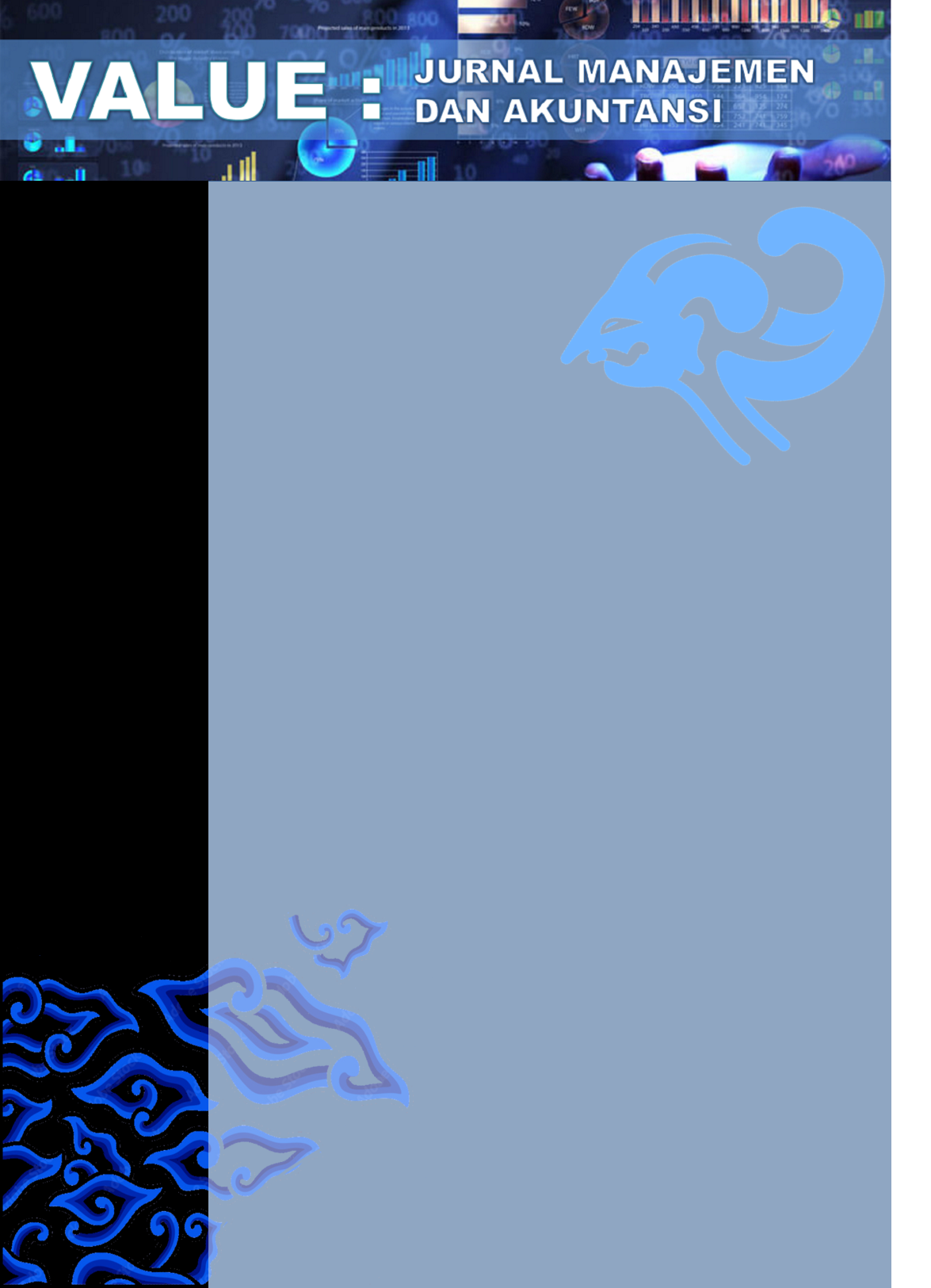Impact Of Size, Leverage, Profitability, Age And Independent Commissioners On Intellectual Capital Disclosure
DOI:
https://doi.org/10.32534/jv.v18i2.4356Keywords:
Determinant, Intellectual Capital , DisclosureAbstract
The publishing of PSAK No. 19 on intangible assets marked the beginning of the idea of intellectual capital in Indonesia. It turns out that even while Indonesia has seen an increase in the disclosure of intellectual property, it is still a very little rise. Companies in Indonesia should be compelled to declare their intellectual property, especially those in the finance industry. This is because the financial services sector employs more intellectual capital in its operations than the industrial sector, which is heavily reliant on information and hence needs more on tangible assets. The purpose of this study is to ascertain how business age, leverage, profitability, and independent commissioners affect the disclosure of intellectual property. This study used a sample of 83 financial sector businesses that were listed on the Indonesia Stock Exchange in 2020–2021. There were 105 enterprises in the population overall. Panel data regression analysis with the Eviews programme version 12 is used in this study. The results of this study show that company age, debt, and business size all have positive and significant effects on the disclosure of intellectual capital. Profitability and the presence of independent commissioners, however, have little bearing on the disclosure of intellectual property. This study also shows that a variety of factors, like firm age, profitability, leverage, and independent commissioners, might affect the disclosure of intellectual property.
References
Aisyah, C. N., & Sudarno. (2014). Pengaruh Struktur Kepemilikan Dan R&D Terhadap Luas Pengungkapan Modal Intelektual. Diponegoro Journal of Accounting, 3(3), 1–9.
Al-Obaidan, A. M. (2008). Bank management and portfolio selection: The case of the Gulf Cooperation Council countries. European Journal of Economics, Finance and Administrative Sciences, 11, 44–56.
Alfianita, W. . & W. A. (2018). Faktor-Faktor Yang MempengaruhiPengungkapan. Jurnal Ekonomi Paradigma, 19(02), 1–75.
Andika, Y. T., & Laksito, H. (2015). Faktor-Faktor yang Mempengaruhi Pengungkapan Modal Intelektual (Studi Empiris pada Perusahaan Perbankan yang terdaftar di Bursa Efek Indonesia Tahun 2012 - 2013). Diponegoro Journal of Accounting, 4(1), 177–190.
Anggeline, E. M., & Novita, N. (2020). Implikasi Mekanisme Corporate Governance Terhadap Pengungkapan Intellectual Capital. Jurnal Akuntansi Trisakti, 7(1), 55–74.
Aprisa, R., Tanjung, A., & Silfi, A. (2016). PENGARUH UKURAN PERUSAHAAN, PROFITABILITAS, TIPE AUDITOR DAN TIPE INDUSTRI TERHADAP PENGUNGKAPAN MODAL INTELEKTUAL (Studi Empiris Pada Perusahaan yang Termasuk Dalam Indeks Kompas 100 Tahun 2014 Bursa Efek Indonesia). Jurnal Online Mahasiswa Fakultas Ekonomi Universitas Riau, 3(1), 1393–1406.
Asfahani, E. S. (2017). Pengaruh Ukuran Perusahaan, Profitabilitas, Leverage, Umur Perusahaan Dan Kepemilikan Pemerintah Terhadap Pengungkapan Intellectual Capital. Jurnal Ekonomi Ak Untansi, 3(3), 40–61.
Ashari, P. M. S., & Putra, I. N. W. A. (2016b). Pengaruh Umur Perusahaan, Ukuran Perusahaan, Profitabilitas, Leverage Dan Komisaris Independen Terhadap Pengungkapan Modal Intelektual. E-Jurnal Akuntansi Universitas Udayana, 14(3), 1699–1726.
Azzahro, F. S. (2019). Pengaruh Leverage Dan Profitabilitas Terhadap Pengungkapan Intellectual Capital Pada Perusahaan Manufaktur Yang Terdaftar Di Bursa Efek Indonesia (Bei) Periode 2014-2018 (Vol. 6, Issue 1).
Bhatia, M., & Agarwal, B. (2015). Intellectual Capital Disclosures in IPO Prospectuses of Indian Companies. International Journal of Social Sciences and Management, 2(1), 40–51.
Bohalima, E. R., Zai, A. N., & Sitepu, W. R. B. (2021). Analisis Faktor-Faktor Yang Memengaruhi Intellectual Capital Disclosure Pada Perusahaan Jasa Yang Terdaftar Di Bursa Efek Indonesia Periode Tahun 2017-2019. Akuntansi Dewantara, 5(1), 33–49.
Bontis, & Nick. (1998). Intellectual capital: an exploratory study that develops measures and models. Management Decision, 36(2), 63–76.
Branswijck, D., & Everaert, P. (2012). The influence of myopic R&D investment behavior on firm performance: evidence from the Belgium, the Netherlands, France and Germany. Roychowdhury.
Brigham, Eugene, F., & Houston, J. F. (2001). Manajemen Keuangan (8th ed.). Erlangga.
Brüggen, A., Vergauwen, P., & Dao, M. (2009). Determinants of intellectual capital disclosure: Evidence from Australia. Management Decision, 47(2), 233–245.
Delvia, Y., & Alexander, N. (2019). the Effect of Size, Firm Age, Growth, Audit Reputation, Ownership and Financial Ratio on Intellectual Capital Disclosure. Jurnal Bisnis Dan Akuntansi, 20(1), 69–76.
Dewi, L. U., Dewi, P. E. D. M., & Julianto, I. P. (2020). Pengaruh Greed, Opportunity, Pressure, dan Efektivitas Pengendalian Internal terhadap Financial Statement Fraud. In Jurnal Ilmiah Akuntansi dan Humanika (Vol. 10, Issue 1).
Dwipayani, A. A., & Putri, I. G. A. M. A. D. (2016). Faktor-Faktor Yang Berpengaruh Pada Pengungkapan Intellectual Capital. E-Jurnal Ekonomi Dan Bisnis Universitas Udayana, 5(11), 3793–3822.
Fabozzi, F. ., & Drake, P. . (2009). Finance (Capital Markets, Financial. Managemen, Investment Management). Jhon Wiley & Sons.
Fahmi, I. (2017). Analisis Laporan Keuangan. Alfabeta.
Faradina, S. (2016). Faktor-Faktor Yang Mempengaruhi Pengungkapan Intellectual Capital Pada Perusahaan Property Dan Real Estate. Esensi, 5(2).
Febrina, H. (2015). Analisis Faktor-faktor yang Mempengaruhi Pengungkapan. Modal Intelektual. Universitas Jendral Soedirman.
Ferreira, A. L., Branco, M. C., & Moreira, J. A. (2012). Factors influencing intellectual capital disclosure by Portuguese companies. International Journal of Accounting and Financial Reporting, 2(2), 278.
Firer, S., & Mitchell Williams, S. (2003). Intellectual capital and traditional measures of corporate performance. Journal of Intellectual Capital, 4(3), 348–360.
Gho, P. C. (2005). Intellectual capital performance of commercial banks in Malaysia. Journal of Intellectual Capital, 6(3), 385–396.
Gregory, W., Alina, L., & Greg, T. (2007). Drivers of voluntary intellectual capital disclosure in listed biotechnology companies. Journal of Intellectual Capital, 8(3), 517.
Gujarati, D. ., & Porter, D. C. (2009). Basic Econometrics (5th ed.). McGraw-Hill.
Herlina, Hapsari, I., Santoso, S. B., & Azizah, S. N. (2021). Pengaruh Proporsi Komisaris Independen, Profitability, Leverage Dan Ukuran Perusahaan Terhadap Intellectual Capital Disclosure. RATIO: Reviu Akuntansi Kontemporer Indonesia, 2(1), 15–24.
Himawan, F. A. (2021). Pengaruh Ukuran Perusahaan, Profitabilitas, Leverage dan Lenght of Listing Terhadap Pengungkapan Intellectual Capital. Jurnal Eksplorasi Akuntansi, 3(1), 112–136.
Istanti, S. L. W. (2009). Faktor-Faktor Yang Mempengaruhi Pengungkapan Sukarela Modal Intelektual (Studi Empiris PadaPerusahaan Non Keuangan Yang Listing Di BEI). Universitas Diponegoro.
Jensen, Michael C., & Meckling, W. H. (1976). Theory of the firm: Managerial behavior, agency costs and ownership structure. Journal of Financial Economics, 3(4), 305–360.
Joson, M., & Susanti, M. (2015). Pengaruh Firm Size, Profitability, Firm Age, Firm Growth, Leverage, Dan Indeendent Commissioner Terhadap Intellectual Capital Disclosure. Jurnal Ekonomi, XX(2), 287–303.
Kasmir. (2017). Analisis Laporan Keuangan. Raja Grafindo Persada.
Komite Nasional Kebijakan Governance. (2006). Pedoman Umum Good Corporate Governance Indonesia.
Kumala, K. S., & Sari, M. M. R. (2016). Pengaruh Ownership Retention, Leverage, Tipe Auditor, Jenis Industri Terhadap Pengungkapan Intellectual Capital. E-Jurnal Akuntansi, 14(1), 1–18.
Linda, L., Affriza, N., & Ismaulina, I. (2019). Pengaruh Ownership Retention, Size, Leverage Dan Komisaris Independen Terhadap Pengungkapan Intellectual Capital. J-ISCAN: Journal of Islamic Accounting Research, 1(2), 65–82.
Lubis, R. H., & Ovami, D. C. (2020). Pengaruh Modal Intelektual Terhadap Kinerja Keuangan. Jurnal Riset Akuntansi Dan Bisnis, 20(1), 61–66.
Luthan, E., Ayu, S., & . I. (2018). The Effect of Corporate Governance Quality, Firm Size, Leverage, and Financial Performance on Intellectual Capital DisclosureEmpirical Study: Manufacturing Companies Listed on the IDX. International Journal of Engineering & Technology, 7(2.29), 421.
Maryam, S. (2014). Analisis Pengaruh Firm Size, Growth, Leverage, Dan Profitabilitas Terhadap Nilai Perusahaan (Studi Pada Perusahaan Manufaktur Yang Terdaftar Di Bursa Efek Indonesia). Universitas Hasanuddin.
Morariu, C. M. (2013). The determinants of intellectual capital disclosure: Evidence from Romania. Research in Accounting in Emerging Economies, 13, 163–186.
Morin, R., Hutadjulu, L. Y., & A Simanjuntak, A. M. (2019). Pengaruh Karakteristik Perusahaan Dan Corporate Governance Terhadap Intellectual Capital Disclosure Serta Dampaknya Terhadap Nilai Perusahaan. Jurnal Akuntansi & Keuangan Daerah, 14(2), 80–97.
Nafisah, L., & Meiranto, W. (2017). Pengaruh Karakteristik Perusahaan Terhadap Pengungkapan Modal Intelektual Dalam Prospektus Ipo. Diponegoro Journal of Accounting, 6(3), 1–11.
Nasution, A. A., & Ovarni, D. C. (2021). Modal Intelektual Dan Nilai Perusahaan Asuransi Di Indonesia. Kajian Akuntansi Universitas Islam Bandung, 22(2), 162–174.
Nikolaj Bukh, P., Nielsen, C., Gormsen, P., & Mouritsen, J. (2005). Disclosure of information on intellectual capital in Danish IPO prospectuses. Accounting, Auditing & Accountability Journal, 18(6), 713–732.
Novrian, R., Arfan, M., & Djalil, M. A. (2020). The Influence of Firm Size, Age, And And Profitability on Intellectual Capital Disclosure of Indonesian Banking Industry. East African Scholars Journal of Economics, Business, and Management, 4464(4), 330–335.
Nugroho, Ahmadi. (2012). FAKTOR-FAKTOR YANG MEMPENGARUHI INTELLECTUAL CAPITAL DISCLOSURE (ICD). Aaj, 1(2).
Prabowo, D., & Purwanto, A. (2019). Analisis Faktor-Faktor Yang Mempengaruhi Intellectual Capital Disclosure Dan Pengaruh Intellectual Capital Disclosure Terhadap Market Capitalization. Diponegoro Journal of Accounting, 1–8.
Pramestiningrum. (2013). Pengaruh Intellectual Capital Terhadap Kinerja Perusahaan Sektor Keuangan Yang Terdaftar Di Bursa Efek Indonesia Tahun 2009-2011.
Priyanti, S. Y., & Wahyudin, A. (2015). Determinan Pengungkapan Modal Intelektual Berdasarkan Variabel Keuangan dan Non Keuangan. In Accounting Analysis Journal (Vol. 4, Issue 2).
Pulic, Bornemann, M., & Leitner, K.-H. (2002). Measuring and Reporting Intellectual Capital: The Case of a Research Technology Organisation. Singapore Management Review, 24(3), 7–19.
Purnomosidhi, Bambang. 2006. Praktik Pengungkapan Modal Intelektual pada Perusahaan Publik di BEJ. Junal Riset Akuntansi Indonesia. Vol.9, No.1, Hal.1-20.
Putra, I. G. C. (2012). Pengaruh Modal Intelektual Pada Nilai Perusahaan Perbankan Yang Go Public Di Bursa Efek Indonesia. Jurnal Ilmiah Akuntansi Dan Humanika, 2(1), 1–22.
Rahayuni, N., Solikhah, B., & Wahyudin, A. (2018). Mampukah Kinerja Keuangan Memediasi Pengaruh Mekanisme Corporate Governance Terhadap Pengungkapan Modal Intelektual? Jurnal Kajian Akuntansi, 2(1), 67.
Roos, J., G., Roos, N. C., Dragonetti, & Edvinsson, L. (1998). Intellectual Capital ? Navigating in the New Business Landscape. In Business Process Management Journal (Vol. 4, Issue 1).
Ruiz-Palomo, D., León-Gómez, A., & García-Lopera, F. (2020). Disentangling organizational commitment in hospitality industry: The roles of empowerment, enrichment, satisfaction and gender. International Journal of Hospitality Management, 90.
Sari, B. N., & Ovami, D. C. (2022). Analisis Determinan Intelectual Capital Disclosure Pada Perusahaan Real Estate dan Property di Indonesia. 3(2), 146–155.
Sari, E. N., & Arisanti, Y. (2018). … Intellectual Capital Di Dalam Laporan Tahunan (Studi Pada Perusahaan Food and Beverages Yang Terdaftar Di Bursa Efek Indonesia Tahun 2010-2014). Methosika: Jurnal Akuntansi Dan.
Septiana, G. R., & Yuyetta, E. N. A. (2013). Analisis Faktor-Faktor Yang Mempengaruhi Pengungkapan Intellectual Capital Pada Prospektus IPO. Diponegoro Journal of Accounting, 2(3).
Setianto, A. P., & Purwanto, A. (2014). Analisis Faktor-faktor yang Mempengaruhi Pengungkapan Modal Intelektual (Studi Empiris pada Perusahaan yang Terdaftar di “Indeks Kompas 100” Tahun 2010-2012). Diponegoro Journal of Accounting, 3(3), 14–28.
Setyaningsih, R. N. (2015). Faktor-Faktor Yang Mampengaruhi Modal Intelektual. Universitas Diponegoro.
Sintyana, I. P. H., & Artini, L. G. S. (2019). Pengaruh Profitabilitas, Struktur Modal, Ukuran Perusahaan Dan Kebijakan Dividen Terhadap Nilai Perusahaan. E-Jurnal Manajemen Universitas Udayana, 8(2).
Stewart, T. . (1997). Intellectual capital: The new wealth of organizations. In Long Range Planning (Vol. 30, Issue 6). Nicholas Brealey Publishing.
Sugiyono. (2021). METODE PENELITIAN KUANTITATIF KUALITATIF DAN R&D (2nd ed.). Alfabeta.
Susanti, S. (2016). Pengaruh Intellectual Capital Terhadap Nilai Perusahaan Perbankan Di Bei Periode 2013-2015. Jurnal Bisnis Darmajaya, 2(2), 146–159.
Suwardjono. (1986). Pokok-pokok pikiran Paton & Littleton tentang prinsip akuntansi untuk perseroan. BPFE Yogyakarta.
Suwarti, T., Mindarti, C. S., & Setianingsih, N. (2016). Analisis Pengaruh Komisaris Independen, Konsentrasi Kepemilikan terhadap Intellectual Capital Disclosure (ICD) dan Kinerja Perusahaan. Forum Manajemen Indonesia Ke 8, 8(Icd), 1–18.
Ulum, I. (2009a). Analisis inter-relasi antar komponen intellectual capital dan kinerja keuangan perusahaan. In Penelitian dasar keilmuan DPP.
Ulum, I. (2009b). Intellectual Capital Konsep dan Kajian Empiris. In Jurnal Inferensi (Vol. 7, Issue 1).
Ulum, Ihyaul, Jati, A. W., Audina, M. I., & Prasetyo, A. (2020). The Influence of Firm’s Characteristics on the Level of Intellectual Capital Disclosure of Indonesian Islamic Banking. 6–10.
V,Sujarweni, W. (2019). Analisis Laporan Keuangan aplikasi dan hasil penelitian. In Pustaka Baru Press.
Wahyuni, M. A., & Rasmini, N. K. (2016). Pengaruh Mekanisme Corporate Governance Pada Pengungkapan Modal Intelektual. Jurnal Buletin Studi Ekonomi Vol., Vol. 21(1), pp 48-59.
Werner, R. M. (2013). Analisis Laporan Keuangan Proyeksi dan Valuasi Saham. In Salemba Empat.
Wicaksono, D. (2021). Analisis Pengaruh Ukuran Perusahaan Dan Komisaris Independen Terhadap Pengungkapan Intellectual Capital Dengan Profitabilitas Sebagai Variabel Moderasi. Kinerja, 3(1), 123–138.
Yuniasih, N. W., Rasmini, N. ketut, & Wirakusuma, M. G. (2012). Pengaruh Pajak Dan Tunneling Incentive Pada Keputusan Transfer Pricing Perusahaan Manufaktur Yang Listing Di Bursa Efek Indonesia. Simposium Nasional Akuntansi, 15(1), 1–23.


















